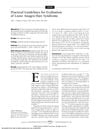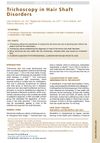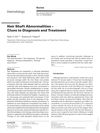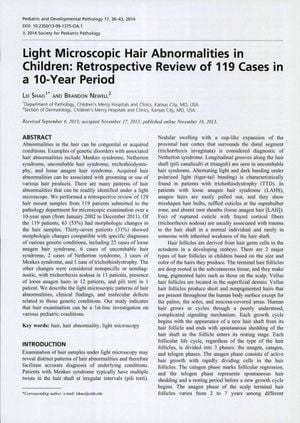TLDR Over half of the children had abnormal hair under a microscope, with many having genetic hair conditions.
In the retrospective review of 119 pediatric cases over a 10-year period, 63 (53%) patients showed morphologic changes in hair samples under light microscopy. Of these, 37 (31%) were diagnosed with specific genetic hair conditions: 25 with loose anagen hair syndrome, 6 with uncombable hair syndrome, 2 with Netherton syndrome, 3 with Menkes syndrome, and 1 with trichothiodystrophy. The rest had nonspecific or nondiagnostic changes such as trichorrhexis nodosa, presence of loose anagen hairs, and pili torti. The study demonstrated the utility of light microscopic hair examination as a noninvasive diagnostic tool for identifying various pediatric hair disorders.
 46 citations
,
October 2009 in “Archives of Dermatology”
46 citations
,
October 2009 in “Archives of Dermatology” Loose anagen hair syndrome, often affecting young girls, can be diagnosed with a hair-pull test and usually gets better on its own, but severe cases may need treatment.
17 citations
,
September 2009 in “British Journal of Dermatology” Fragile hair in children is rarely linked to trichothiodystrophy (TTD).
71 citations
,
May 2006 in “The journal of investigative dermatology/Journal of investigative dermatology” TTD hair brittleness is caused by multiple structural abnormalities.
372 citations
,
December 2004 in “Nature Genetics” 84 citations
,
April 2002 in “Archives of Dermatology” Loose anagen hair syndrome may be caused by keratin gene mutations.
175 citations
,
December 1980 in “Archives of Dermatology” Trichothiodystrophy is a condition with brittle hair and various physical and mental issues due to low sulfur in proteins.
 36 citations
,
August 2018 in “Dermatologic Clinics”
36 citations
,
August 2018 in “Dermatologic Clinics” Trichoscopy is a useful tool for diagnosing hair disorders without pulling out hair.
 44 citations
,
January 2005 in “Dermatology”
44 citations
,
January 2005 in “Dermatology” Hair problems can be caused by genetics or the environment, and treatment should focus on the cause and reducing hair damage.
 12 citations
,
November 1987 in “Pediatric dermatology”
12 citations
,
November 1987 in “Pediatric dermatology” Four children had unmanageable pale blond hair due to uncombable-hair syndrome.
33 citations
,
December 1982 in “Developmental Medicine & Child Neurology” Hair-shaft abnormalities can indicate neurological disorders, some of which are treatable.




